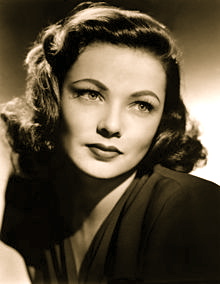Gene Tierney
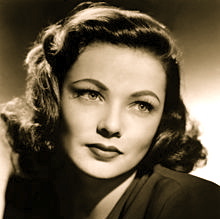
Gene Tierney: A Shattered Portrait
Gene Eliza Tierney (November 19, 1920 – November 6, 1991) was an American film and stage actress. Acclaimed as a great beauty, she became established as a leading lady. Tierney was best known for her portrayal of the title character in the film Laura (1944), and was nominated for an Academy Award for Best Actress for her performance as Ellen Berent Harland in Leave Her to Heaven (1945).
Other notable roles include Martha Strable Van Cleve in Heaven Can Wait (1943), Isabel Bradley Maturin in The Razor’s Edge (1946), Lucy Muir in The Ghost and Mrs. Muir (1947), Ann Sutton in Whirlpool (1949), Maggie Carleton McNulty in The Mating Season (1951) and Anne Scott in The Left Hand of God (1955).
Early Life
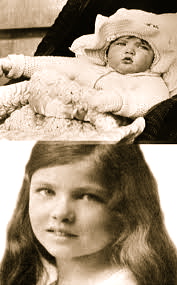 Tierney was born in Brooklyn, New York, the daughter of Howard Sherwood Tierney and Belle Lavina Taylor. She was named after a beloved uncle, who died young. She had an elder brother, Howard Sherwood “Butch” Tierney, Jr., and a younger sister, Patricia “Pat” Tierney. Their father was a successful insurance broker of Irish descent, their mother a former physical education instructor.
Tierney was born in Brooklyn, New York, the daughter of Howard Sherwood Tierney and Belle Lavina Taylor. She was named after a beloved uncle, who died young. She had an elder brother, Howard Sherwood “Butch” Tierney, Jr., and a younger sister, Patricia “Pat” Tierney. Their father was a successful insurance broker of Irish descent, their mother a former physical education instructor.
Tierney attended St. Margaret’s School in Waterbury, Connecticut, and the Unquowa School in Fairfield. She published her first poem, entitled “Night,” in the school magazine, and she wrote poetry occasionally throughout her life. Tierney played Jo in a student production of Little Women, based on the novel by Louisa May Alcott.
She spent the next two years in Europe, attending Brillantmont International School in Lausanne, Switzerland, where she learned to speak fluent French. She returned to the U.S. in 1938 and attended Miss Porter’s School in Connecticut. On a trip to the West Coast, she visited Warner Bros. studios. Director Anatole Litvak, taken by the seventeen-year-old’s beauty, told her that she should become an actress. Warner Brothers wanted to sign her to a contract, but her parents advised against it because of the relatively low salary; they also wanted her in a higher social position.
Tierney’s society debut occurred on September 24, 1938, when she was 17 years old. Soon bored with society life, she decided to pursue an acting career. Her father said, “If Gene is to be an actress, it should be in the legitimate theatre.” Tierney studied acting at a small Greenwich Village acting studio in New York with Broadway director and actor Benno Schneider. She became a protégée of Broadway producer-director George Abbott.
Career – Broadway
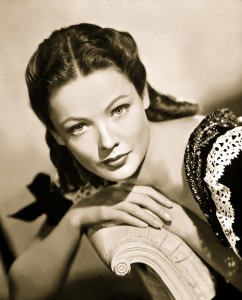 In Tierney’s first part on Broadway, she carried a bucket of water across the stage in What a Life! (1938). A Variety magazine critic declared, “Miss Tierney is certainly the most beautiful water carrier I’ve ever seen!” She also worked as understudy in The Primrose Path (1938).
In Tierney’s first part on Broadway, she carried a bucket of water across the stage in What a Life! (1938). A Variety magazine critic declared, “Miss Tierney is certainly the most beautiful water carrier I’ve ever seen!” She also worked as understudy in The Primrose Path (1938).
The following year, she appeared in the role of Molly O’Day in the Broadway production Mrs. O’Brien Entertains (1939). The New York Times critic Brooks Atkinson wrote, “As an Irish maiden fresh from the old country, Gene Tierney in her first stage performance is very pretty and refreshingly modest.” That same year, Tierney appeared as Peggy Carr in Ring Two (1939) to favorable reviews. Theater critic Richard Watts, Jr. of the New York Herald Tribune wrote, “I see no reason why Miss Tierney should not have an interesting theatrical career – that is, if cinema does not kidnap her away.”
Tierney’s father set up a corporation, Belle-Tier, to fund and promote her acting career. Columbia Pictures signed her to a six-month contract in 1939. She met Howard Hughes, who tried unsuccessfully to seduce her. From a well-to-do family, she was not impressed by his wealth. Hughes eventually became a lifelong friend.
After a cameraman advised Tierney to lose a little weight, she wrote Harper’s Bazaar magazine for a diet, which she followed for the next twenty-five years. Tierney was offered the lead role in National Velvet, but production was delayed. National Velvet was produced at MGM in 1944.
When Columbia Pictures failed to find Tierney a project, she returned to Broadway and starred as Patricia Stanley to critical and commercial success in The Male Animal (1940). In The New York Times, Brooks Atkinson wrote, “Tierney blazes with animation in the best performance she has yet given.” She was the toast of Broadway before her 20th birthday. The Male Animal was a hit, and Tierney was featured in Life magazine. She was also photographed by Harper’s Bazaar, Vogue and Collier’s Weekly.
Two weeks after The Male Animal opened, there was a rumor that Darryl F. Zanuck, the head of 20th Century Fox, was in the audience. During the performance, he told an assistant to note Tierney’s name. Later that night, Zanuck dropped by the Stork Club, where he saw a young lady on the dance floor. He told his assistant, “Forget the girl from the play. See if you can sign that one.” It was Tierney. At first Zanuck did not think she was the actress he’d seen. Tierney was quoted (after the fact), saying: “I always had several different ‘looks’, a quality that proved useful in my career.”
Film Career
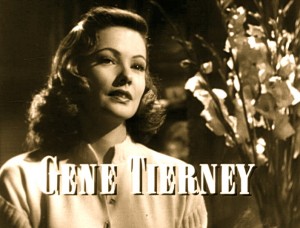 Gene Tierney in the film trailer for Laura (1944)
Gene Tierney in the film trailer for Laura (1944)
Hollywood called again and Tierney signed with 20th Century-Fox. Her motion picture debut was in a supporting role as Eleanor Stone in Fritz Lang’s western The Return of Frank James (1940), opposite Henry Fonda.
A small role as Barbara Hall followed in Hudson’s Bay (1941) with Paul Muni. In what was a major year of work, Tierney co-starred as Ellie Mae Lester in John Ford’s comedy Tobacco Road, along with the title role in Belle Starr, Zia in Sundown and Victoria Charteris (a.k.a. Poppy Smith) in The Shanghai Gesture. In 1942, she played Eve in Son of Fury: The Story of Benjamin Blake, along with the dual role of Susan Miller (a.k.a. Linda Worthington) in Rouben Mamoulian’s screwball comedy film Rings on Her Fingers, Kay Saunders in Thunder Birds, and Miss Young in China Girl.
Receiving top billing in Ernst Lubitsch’s classic 1943 comedy Heaven Can Wait, as Martha Strable Van Cleve, signaled an upward turn in Tierney’s career, and her popularity increased. Tierney recalled that, during the production of Heaven Can Wait:
“Lubitsch was a tyrant on the set, the most demanding of directors. After one scene, which took from noon until five to get, I was almost in tears from listening to Lubitsch shout at me. The next day I sought him out, looked him in the eye, and said, ‘Mr. Lubitsch, I’m willing to do my best but I just can’t go on working on this picture if you’re going to keep shouting at me.’ ‘I’m paid to shout at you’, he bellowed. ‘Yes’, I said, ‘and I’m paid to take it – but not enough.’ After a tense pause, Lubitsch broke out laughing. From then on we got along famously.”
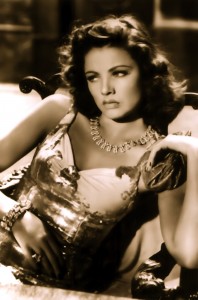 In 1944, she starred in what became her most famous role: the title role in Otto Preminger’s film noir Laura, opposite Dana Andrews. After playing Tina Tomasino in A Bell for Adano (1945), she played the jealous, narcissistic femme fatale Ellen Berent Harland, opposite Cornel Wilde, in the film version of the best-selling novel, Leave Her to Heaven by Ben Ames Williams. Her performance won her an Academy Award nomination for Best Actress (1945). This was 20th Century-Fox’ most successful film of the 1940’s. It was cited by acclaimed director Martin Scorsese as one of his favorite films of all time, and he assessed Tierney as one of the most underrated actresses of the Golden Era.
In 1944, she starred in what became her most famous role: the title role in Otto Preminger’s film noir Laura, opposite Dana Andrews. After playing Tina Tomasino in A Bell for Adano (1945), she played the jealous, narcissistic femme fatale Ellen Berent Harland, opposite Cornel Wilde, in the film version of the best-selling novel, Leave Her to Heaven by Ben Ames Williams. Her performance won her an Academy Award nomination for Best Actress (1945). This was 20th Century-Fox’ most successful film of the 1940’s. It was cited by acclaimed director Martin Scorsese as one of his favorite films of all time, and he assessed Tierney as one of the most underrated actresses of the Golden Era.
In 1946, Tierney starred as Miranda Wells in in Dragonwyck, Joseph L. Mankiewicz’ debut film as a director, along with Walter Huston and Vincent Price. That same year, she starred as Isabel Bradley, opposite Tyrone Power, in The Razor’s Edge, an adaptation of W. Somerset Maugham’s novel of the same name. Her performance was critically praised.
She followed that with her role as Lucy Muir in Mankiewicz’ The Ghost and Mrs. Muir (1947), opposite Rex Harrison. The following year, Tierney co-starred again with Power, this time as Sara Farley in the successful screwball comedy That Wonderful Urge (1948). As the decade came to a close, Tierney reunited with Laura director Preminger to star as Ann Sutton in the classic film noir Whirlpool (1949), co-starring Richard Conte and José Ferrer. She gave memorable performances in two other films noirs (both in 1950) – Jules Dassin’s Night and the City and Otto Preminger’s Where the Sidewalk Ends.
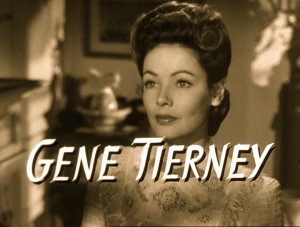 From the trailer for The Ghost and Mrs. Muir (1947)
From the trailer for The Ghost and Mrs. Muir (1947)
In 1951, Tierney was loaned to Paramount Pictures, where she gave a memorable comic turn as Maggie Carleton in Mitchell Leisen’s classic ensemble farce, The Mating Season, with John Lund, Thelma Ritter and Miriam Hopkins. That same year she gave a tender performance as Midge Sheridan in the Warner Bros. film, Close to My Heart (1951), with Ray Milland. The film is about a couple trying to adopt a child. Later in her career she was reunited with Milland in Daughter of the Mind (1969).
After Tierney appeared opposite Rory Calhoun as Teresa in Way of a Gaucho (1952), her contract at 20th Century-Fox expired. That same year she starred as Dorothy Bradford in Plymouth Adventure, opposite Spencer Tracy at MGM. She and Tracy had a brief affair during this time. Tierney played Marya Lamarkina opposite Clark Gable in Never Let Me Go (1953), filmed in England.
Tierney remained in Europe to play Kay Barlow in United Artists’ Personal Affair (1953), which was released that same year. While in Europe, she began a romance with Prince Aly Khan, but their marriage plans met with fierce opposition from his father Aga Khan III. Early in 1953, Tierney returned to the U.S. to co-star in a film noir as Iris Denver in Black Widow (1954), with Ginger Rogers and Van Heflin.
Health Issues
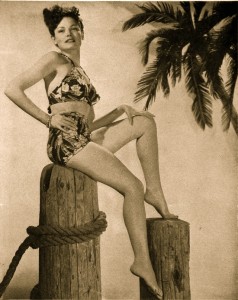 Pin-up photo in World War II magazine Brief
Pin-up photo in World War II magazine Brief
Because of the sad events in her life, including a daughter born severely mentally disabled, Tierney struggled for years with episodes of depression. In 1953, she suffered problems with concentration, which affected her filmmaking. She dropped out of Mogambo and was replaced by Grace Kelly. While playing Anne Scott in The Left Hand of God (1955), opposite Humphrey Bogart, Tierney became ill. (Bogart had personal experience, as he was close to a sister who suffered from mental illness.) During the production, he fed Tierney her lines and encouraged her to seek help.
Tierney consulted a psychiatrist and was admitted to Harkness Pavilion in New York. Later, she went to The Institute of Living in Hartford, Connecticut. After some 27 shock treatments, intended to alleviate severe depression, Tierney fled the facility, but she was caught and returned. She became an outspoken opponent of shock treatment therapy, claiming that it had destroyed significant portions of her memory.
In late December 1957, Tierney stepped from her mother’s apartment in Manhattan onto a ledge 14 stories up and stood there for about 20 minutes, in what was considered a suicide attempt. The police were called, and Tierney’s family arranged for her to be admitted to the Menninger Clinic in Topeka, Kansas. She was released from Menninger the following year after treatment for depression. She worked for a time as a sales girl in a local dress shop as part of integrating back into society. (She was recognized by a customer, resulting in sensational newspaper headlines).
Later that year, 20th Century-Fox offered Tierney a lead role in Holiday for Lovers (1959), but she found the stress proved too great. Days into production, she dropped out of the film and returned to Menninger for a time.
Comeback
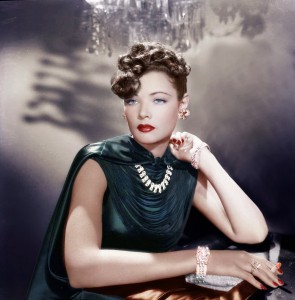 Tierney made a screen comeback in Advise and Consent (1962), co-starring with Franchot Tone. A year later, she played Albertine Prine in Toys in the Attic, based on the play by Lillian Hellman. This was followed by the international production of Las cuatro noches de la luna llena, aka “Four Nights of the Full Moon” (1963), in which she starred with Dan Dailey. She received overall critical praise for her performances.
Tierney made a screen comeback in Advise and Consent (1962), co-starring with Franchot Tone. A year later, she played Albertine Prine in Toys in the Attic, based on the play by Lillian Hellman. This was followed by the international production of Las cuatro noches de la luna llena, aka “Four Nights of the Full Moon” (1963), in which she starred with Dan Dailey. She received overall critical praise for her performances.
Tierney’s career turn as a solid character actress seemed to be on track. She played Jane Barton in The Pleasure Seekers (1964), then again retired. Tierney returned to star in the television movie Daughter of the Mind (1969) with Don Murray and Ray Milland. Her final performance was in the TV miniseries Scruples (1980).
Personal Life
Tierney married twice, first to Oleg Cassini, a costume and fashion designer, on June 1, 1941, with whom she eloped. Her parents opposed the marriage, as he was from a Russian-Italian family and born in Europe. She and Cassini had two daughters, Antoinette Daria Cassini (October 15, 1943 – September 11, 2010)[11] and Christina “Tina” Cassini (born November 19, 1948), born after their first divorce.
In June 1943, while pregnant with Daria, Tierney contracted rubella (German measles), likely from a fan ill with the disease. Daria was born prematurely in Washington, D.C., weighing three pounds, two ounces (1.42 kg) and requiring a total blood transfusion. The rubella had caused genetic damage: Daria was found to be deaf, partially blind with cataracts, and was severely mentally disabled. She later was institutionalized for much of her life.
Tierney’s friend Howard Hughes paid for the medical expenses of Daria, ensuring the girl received the best care. Tierney never forgot his acts of kindness.
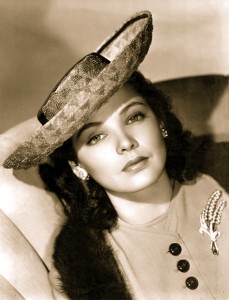 Tierney and Cassini separated October 20, 1946 and entered into a property settlement agreement November 10, 1946. An uncontested divorce followed in California; their final divorce decree was dated March 13, 1948. The couple reconciled on August 19, 1948, but did not remarry.
Tierney and Cassini separated October 20, 1946 and entered into a property settlement agreement November 10, 1946. An uncontested divorce followed in California; their final divorce decree was dated March 13, 1948. The couple reconciled on August 19, 1948, but did not remarry.
During their separation, Tierney met John F. Kennedy, a young veteran from WWII, who was visiting the set of Dragonwyck in 1946. They began a romance that she ended the following year after Kennedy told her he could never marry her because of his political ambitions. In 1960, Tierney sent Kennedy a note of congratulations on his victory in the presidential election.
Tierney remarried Cassini, but they divorced again on February 28, 1952. “Cassini promised in his 1952 divorce from Gene Tierney that he would write a will leaving both of his daughters half of his fortune.” Cassini later bequeathed $500,000 in trust to Daria and $1,000,000 to Christina. Cassini and Tierney remained friends until her death in November 1991.
In 1958, Tierney met Texas oil baron, W. Howard Lee. He had been married to actress Hedy Lamarr since 1953. They divorced in 1960 after a long battle over alimony. Lee married Tierney in Aspen, Colorado on July 11, 1960. They lived quietly in Houston, Texas and Florida. They were married until his death in 1981.
In 1962, 20th Century Fox announced Tierney would play the lead role in Return to Peyton Place, but she dropped out of the project after becoming pregnant. She later miscarried.
Later Years
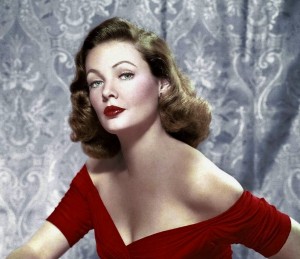 Tierney’s autobiography, Self-Portrait, in which she candidly discussed her life, career and mental illness, was published in 1979. Tierney was widowed when Lee died on February 17, 1981, after a long illness.
Tierney’s autobiography, Self-Portrait, in which she candidly discussed her life, career and mental illness, was published in 1979. Tierney was widowed when Lee died on February 17, 1981, after a long illness.
In 1986, Tierney was honored alongside actor Gregory Peck with the first Donostia Lifetime Achievement Award at the San Sebastian Film Festival in Spain. Also for her contribution to the motion picture industry, Tierney has a star on the Hollywood Walk of Fame at 6125 Hollywood Boulevard.
Death
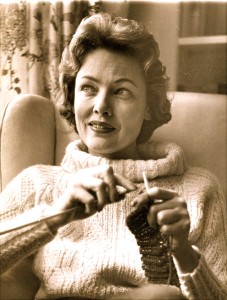 Gene Tierney died of emphysema in 1991 in Houston. She had reportedly started smoking after a screening of her first movie in order to lower her voice because she felt, “I sound like an angry Minnie Mouse.” She became a heavy smoker. She is interred in Glenwood Cemetery in Houston. Tierney was survived by her daughters Daria and Christina. Daria died on September 11, 2010, aged 66, and was interred beside her mother.
Gene Tierney died of emphysema in 1991 in Houston. She had reportedly started smoking after a screening of her first movie in order to lower her voice because she felt, “I sound like an angry Minnie Mouse.” She became a heavy smoker. She is interred in Glenwood Cemetery in Houston. Tierney was survived by her daughters Daria and Christina. Daria died on September 11, 2010, aged 66, and was interred beside her mother.
Certain documents of Tierney’s film-related material, personal papers, letters, etc., are held in the Wesleyan University Cinema Archives, to which scholars, media experts and public from around the world may have full access.

